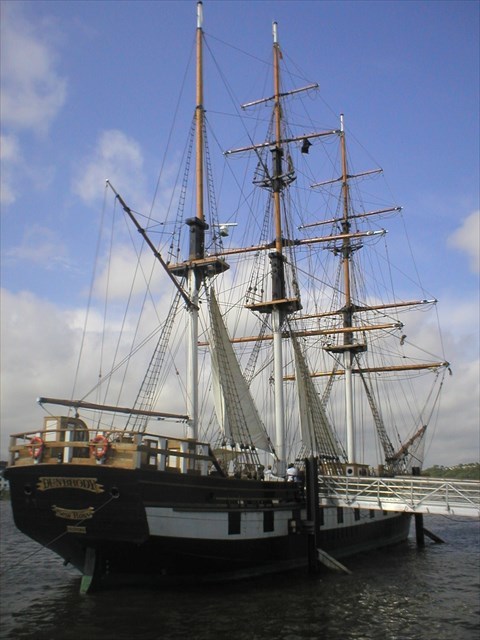
 Dunbrody is a 458 tonne three-masted barque, 176 feet (53.7 metres) long. Her hull length is 120 ft. (36.6 m), she has a beam of 28 ft (8.5 m), a draft of 11.5 ft (3.5 m) and has a sail area of 10,100 square ft. (c. 940 sq. m.). The present ship is a reconstruction of the original Dunbrody, built in Quebec in 1845 by Thomas Hamilton Oliver, an Irish emigrant from Co. Derry. She took less than six months to build under the careful supervision of John Baldwin, who captained her from 1845 to March 1848. The merchant Graves family from New Ross commissioned her. They commissioned eight such ships to carry cargo from America and Canada. Dunbrody is a 458 tonne three-masted barque, 176 feet (53.7 metres) long. Her hull length is 120 ft. (36.6 m), she has a beam of 28 ft (8.5 m), a draft of 11.5 ft (3.5 m) and has a sail area of 10,100 square ft. (c. 940 sq. m.). The present ship is a reconstruction of the original Dunbrody, built in Quebec in 1845 by Thomas Hamilton Oliver, an Irish emigrant from Co. Derry. She took less than six months to build under the careful supervision of John Baldwin, who captained her from 1845 to March 1848. The merchant Graves family from New Ross commissioned her. They commissioned eight such ships to carry cargo from America and Canada.
Dunbrody was primarily a cargo vessel and carried timber from Canada, cotton from the southern states of the USA and guano from Peru. The ship was fitted out with bunks and facilities for passengers desperate to escape the harrowing conditions at home. From 1845 to 1851, between April and September, she carried passengers on her outward journeys to Canada and the USA. She usually carried 176 people but on one crossing, at the height of the Famine in 1847, she carried 313.
Many of the passengers were the evicted tenants of Lord Fitzwilliam's Wicklow estates and Viscount de Vesci's Portlaoise estates. She carried two classes of passenger - the cabin passenger who paid between £5 and £8 and the steerage passenger who paid between £3 15s 0p and £4. This fare was at least the equivalent of two months income for a tenant farmer in the 1840's.
The cabin passengers (usually Protestant gentry) had food and services provided but the steerage passengers had to cook and fend for themselves. 1847 was the worst year of the Famine. In the first open months of the Spring 40 ships were waiting to disembark and the quarantine station at Grosse Île in Canada had more than 1,100 patients suffering in terrible conditions. In May 1847, Captain Baldwin finally landed his passengers at Grosse Île after a very long passage. In a letter addressed to William Graves, he reported "the Dunbrody was detained in quarantine for five days because there were too many ships queuing in the St. Lawrence River. Doctor Douglas is nearly singled-handed….everyday, dozens of corpses are thrown overboard from many ships….I have heard that some of them have no fresh water left and the passengers and crew have to drink the water from the river. God help them!"
Although the Dunbrody was detained at Grosse Île on a number of occasions, her onboard mortality rate was practically non-existent. This was, without doubt, due to her good and humane captains, Captain Baldwin and his successor, Captain John W. Williams. Emigrants writing back home to Ireland praised their dedication to their crew and passengers more than once. Thanks to a very well organised overseas mail system, the Captains were also able to keep in regular contact with William Graves.
Dunbrody remained in the Graves family ownership for 24 years. She was sold in 1869 and became a British registered ship. In 1874, en route to Quebec from Cardiff, Dunbrody's captain chose not to wait for a pilot to assist him in navigating the St. Lawrence. He paid for this when he ran aground. She was fortunate, however, to be bought by a salvage company, repaired and sold on. Unfortunately, in 1875, she took her second and fatal grounding. Sailing home to Liverpool with a full timber cargo worth £12,500, a fierce gale blew up and drove her dangerously off her usual route towards the shores of Labrador. Though the exact details are not known, it is assumed that if she grounded fully laden with a timber cargo, her aging hull would have been broken up beyond economic repair.
Cache Logging Requirements
To log this Virtual Geocache, you must take a picture of your caching name with both the Emigrant Flame and Dunbrody boat (see photo below) in the background, and attach it to your found log.
Please Note:
- The picture should clearly display your caching name and the Dunbrody. Unclear pictures will not be accepted.
- Your name must be included in the picture at the time of taking it and not added afterwards and it should not be digitally added.
- Pictures taken from an unreasonable distance from GZ will not be accepted.
- Do Not send me the picture, attach to your log.
- Logs without a picture may be deleted without notification. If you plan to post the picture at later time, please post a "Write Note" rather than a "Found it" log.
- In regards to Group pictures, the same photo is permitted but all names in the group must be included in the picture and readable. The group photo should be uploaded to the log of each finder.
|